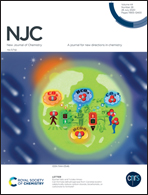Thieno[3,2-c]pyran: an ESIPT based fluorescence “turn-on” molecular chemosensor with AIE properties for the selective recognition of Zn2+ ion†
Abstract
Excited state intramolecular proton transfer (ESIPT) based functionalized thieno[3,2-c]pyran P was designed and synthesized as a fluorescent turn-on chemosensor for the selective recognition of Zn2+ ion with a low detection limit (0.67 μM). Fourier transform infrared spectroscopy (FTIR), NMR, and Job plot studies were used to investigate the binding phenomenon of P and Zn2+, which was achieved via deprotonation of the hydroxyl group. Zn2+ ions undergo interaction with thieno[3,2-c]pyran to afford the complex P–Zn2+, which enhances the weak emissive properties of the chemosensor P up to λem 484 nm via geometrical alteration and termination of the keto to enol oscillation. In addition, thieno[3,2-c]pyran P also showed higher fluorescence in a solution of 60% water in THF owing to the aggregation-induced emission phenomenon. All of these photophysical properties of chemosensor P and complex P–Zn2+ are supported by quantum chemical density functional theory (DFT) calculations. The structure of P was also confirmed using single X-ray crystallography.
![Graphical abstract: Thieno[3,2-c]pyran: an ESIPT based fluorescence “turn-on” molecular chemosensor with AIE properties for the selective recognition of Zn2+ ion](/en/Image/Get?imageInfo.ImageType=GA&imageInfo.ImageIdentifier.ManuscriptID=D0NJ02236E&imageInfo.ImageIdentifier.Year=2020)


 Please wait while we load your content...
Please wait while we load your content...